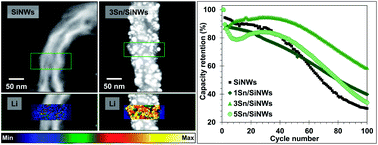Nanometer-scale Sn coatings improve the performance of silicon nanowire LIB anodes†
Abstract
We demonstrate that a thin partially dewetted coating of Sn will improve the cycling performance of silicon nanowire (SiNWs) lithium ion battery (LIB) anodes. The optimum architecture 3Sn/SiNWs (i.e. a Sn layer with an average film thickness of a 3 nm covering the nanowire) maintained a reversible capacity of 1865 mA h g−1 after 100 cycles at a rate of 0.1 C. This is almost double of the baseline uncoated SiNWs, where the reversible capacity after 100 cycles was 1046 mA h g−1 (∼78% improvement). The 1Sn/SiNWs and 3Sn/SiNWs electrodes demonstrated much improved cycling coulombic efficiency, with >99% vs. 94–98% for the baseline. At a high current density of 5 C, these nanocomposite offered 2× the capacity retention of bare SiNWs (∼20 vs. ∼10% of 0.1 C capacity). It is demonstrated that the Sn coating both lithiates and delithiates at a higher voltage than Si and thus imparts a compressive stress around the nanowires. This confines their radial expansion in favor of longitudinal, and reduces the well-known failure mode by lithiation-induced nanowire stranding and fracture. TOF-SIMS analysis on the post-cycled delithiated specimens shows enhanced Li signal near the current collector due to accelerated SEI formation at the interface. FIB demonstrates concurrent en-masse delamination of SEI agglomerated sections of the nanowires from the current collector. Both of these deleterious effects are lessened by the presence of the Sn coatings.


 Please wait while we load your content...
Please wait while we load your content...